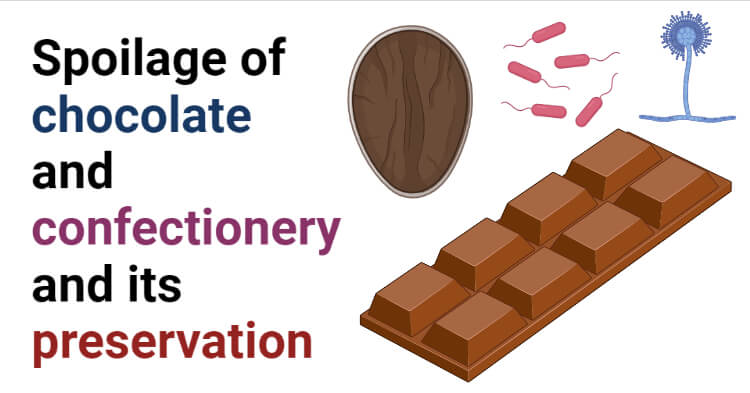Interesting Science Videos
What is a Chocolate?
Chocolate originates from the processing of cacao beans. Cocoa beans are the seeds of the tree Theobroma cacao and they are in pods surrounded by sterile pulp. The beans must be removed from the pods, fermented, dried, roasted, ground, and pressed to be converted to liquid cocoa mass. The finished chocolate product is produced by combining a mixture of one or more cocoa nibs, cocoa mass, cocoa press cake, and cocoa powder including other ingredients or flavoring agents.
Contamination source of chocolate
- the soil and air
- the surface of pods and the hands and tools of harvesters.
- the processing and storage conditions
- poor hygienic handling

Spoilage of chocolate
- Microorganisms found in fermenting cacao included yeasts- Kloeckera, Candida, Saccharomyces, Hanseniaspora, Rhodotorula, Debaryomces. Picliia and Schizosaccharomyces; acetic acid bacteria – Aerobacter rancens. Aerobacter xylinum, Aerobacter ascelldens, and Glucoflobacter oxydans; lactic acid bacteria – Lactobacillus collinoides, and Lb. mali; and Bacillus species – Bacillus cereus. B. licheniformis and B. coagulans; mold- Aspergillus fumigatus, Aspergillus niger, Aspergillus flavus, Aspergillus tamarii, Eurotium spp., Penicillium spp. and Mucor spp.
- The subsequent processing steps of the roasted beans, nibs, or liquor such as milling and refining, mixing, tempering, or molding influence the final flora of chocolate.
- However, changes in the microbial population will be influenced by the addition of ingredients such as milk powder, sugar, nuts, or dried fruits.
- Owing to the inherent low water activity (0.4-0.5) of chocolate it is unlikely to support the growth and proliferation of spoilage-causing and pathogenic microorganisms.
- However, the chocolate melts when stored in an undesirable condition that makes it prone to spoilage-causing and pathogenic microorganisms.
- The bacterial that are found in chocolate are Bacillus spp (Bacillus cereus, B. licheniformis, B. coagulans, B. fumarioli, B. badius, and B. subtilis), Brevibacillus Agri, Alicylobacillus acidocaldarius, and Paenibacillus cokkii.
- Some xerophilic fungi that are found in chocolate are Bettsia alvei (teleomorph of Chrysosporium farinicola) and Chrysosporium xerophilum from spoiled hazelnut chocolate, Neosortorya glabrafrom spoiled chocolate, and Chrysosporium farinicola from chocolate.
- The pathogenic that are found in chocolate are Salmonella, E. coli, and Listeria monocytogenes.
- The defects caused by spoilage-causing microorganisms are
- Soapiness is a defect observed in unsweetened chocolate
- High levels of lipolytic enzymes from Bacillus spp. or molds.
Preservation of chocolate
- Preventing contamination is the only effective way to secure a safe product.
- The quality of the cocoa beans used during manufacturing is very important and will determine the quality of chocolate.
- Irradiation is effective for the control of contamination in both raw cocoa beans and finished chocolate products.
- Simple visual checks of raw materials for good quality of the final chocolate product.
- The presence of condensation in containers or of spoiled packaging material represents a risk so it should be avoided.
- Chocolate tends to absorb moisture so it should be stored in a tight container.
What are Confectionaries?
Confectionaries are sweet, high-sugar products that are shelf-stable. The high-sugar products are characterized as chocolate confectionery and sugar confectionery (non-chocolate). The chocolate confectionery category includes bars, blocks, and bonbons. The sugar confectionery category includes hard candy, soft/gummy candy, caramel, toffee, licorice, marzipan, creams, jellies, and nougats. However, the confectionery products are a very heterogeneous group of products made with dried milk and other dairy products; cocoa and chocolate products; sugar, honey, syrups or sweeteners: nuts, fruits or jams; starches, gelatin, pectin or other thickeners; egg albumen; spices, colors, flavors or acidulants.
Contamination source of confectionaries
- raw ingredients (such as liquid sugar, colors, nuts, dairy products, gelatin, starch, and processed eggs)
- the processing and storage conditions
- poor hygienic handling
- packaging material
- Equipment and machine used
Spoilage of confectionery product
- Water activity plays an important role in controlling the microbial growth in confectionery products.
- These confectionery products can be divided into:
- Cold processed (molded chocolate, cream-filled chocolate)
- Hot processed (hard candy, jellies, toffees, and caramel)
- Hard candies and toffees are least likely to undergo microbial spoilage compared to caramel and cream-filled chocolate.
- The chocolate creams undergo microbial spoilage by Clostridium spp., especially C. sporogenes that contaminate the products through sugars, starch, and possibly other ingredients.
- Products with water activities ranging from 0.60 to 0.83 are susceptible to spoilage by osmophilic yeasts and xerophilic molds.
- The primary microorganisms associated with the spoilage of confectionery products are yeasts Zygosaccharomyces rouxii, Brettanomyces bruxellensis.
- The mold that is found spoiling confectionery products includes Aspergillus, Penicillium, Verticillium, Rhizopus, Mucor, and Trichothecium.
- The defects caused by yeast include bursting/fracturing of products, resulting in leakers, slime formation, off-flavors, and off-odors.
- Mold spoilage the visible appearance of mycelia on the surface of the product.
Preservation of confectionery product
- Confectionery product water activity is so low that it is microbiologically stable and can be stored at room temperature for several months.
- Controlling the moisture content will prevent the spoilage of confectionery products.
- Most commonly used preservative includes potassium sorbate and sodium benzoate
- Many products are thermally processed at temperatures greater than 93.3◦C, which will kill vegetative bacteria, yeasts, and molds.
References
- HAWTHORN, J. (1969). Organisms in Foods. In Nature (Vol. 224). https://doi.org/10.1038/224196b0
- Heredia, N., & García, S. (2008). Food Safety Issues and the Microbiology of Chocolate and Sweeteners. Microbiologically Safe Foods, 367–376. https://doi.org/10.1002/9780470439074.ch18
- Jay, J. M. (2000).Modern food microbiology Sixth edition.
- Juhaniaková, Ľ., Petrová, J., Hleba, L., Kunová, S., Bobková, A., & Kačániová, M. (2014). MICROBIOLOGICAL ANALYSIS OF DIFFERENT CONFECTIONERY PRODUCTS. Retrieved from http://www.gomc.com/firstpage/201003046.pdf
- Kačániová, M., & Juhaniaková, Ľ. (2011). MICROORGANISMS IN CONFECTIONERY PRODUCTS. In Journal of Microbiology, Biotechnology and Kačániová and Juhaniaková (Vol. 1).
- Potter, N. N., & Hotchkiss, J. H. (1995). Confectionery and Chocolate Products SUGAR-BASED CONFECTIONS. 464–477.
- Thompson, S. (2009). Compendium of the Microbiological Spoilage of Foods and Beverages. Compendium of the Microbiological Spoilage of Foods and Beverages. https://doi.org/10.1007/978-1-4419-0826-1.
